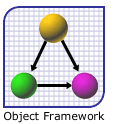|
What is Object Framework?
 BankNet's
Object Framework™ Software Product Offering serves as the backbone for application
software components deployed on the Enterprise (IBM S390) platform. It provides
management of the organization's enterprise-wide inventory of application
objects. Object Framework dispatches the services of these objects by brokering
requests. Key features and benefits are consistency, efficiency, and platform
neutrality, which are achieved by:
1.Reuse Brokering BankNet's
Object Framework™ Software Product Offering serves as the backbone for application
software components deployed on the Enterprise (IBM S390) platform. It provides
management of the organization's enterprise-wide inventory of application
objects. Object Framework dispatches the services of these objects by brokering
requests. Key features and benefits are consistency, efficiency, and platform
neutrality, which are achieved by:
1.Reuse Brokering
2.Component Warehousing
3.Facilitatiing Interapplication/Cross Platform Requests through XML
4.Bridging Legacy Applications to the Internet

1. Reuse Brokering
Object Framework defines a specification for the design of reusable application components.
According to a simple request/reply programming model, each function accepts an input message and returns a reply message.
This promotes a consistent, enterprise-wide component technology that enables the company to leverage its application
software assets through reuse.
Object Framework uses the Object Oriented Programming paradigm.
The application developer defines reusable components as classes and methods, and implements the basic OO principles:
Encapsulation, Inheritance, and Polymorphism.
2. Component Warehousing
Each application group within the enterprise maintains its own Object Framework registry of reusable components.
The result is a consolidated enterprise-wide component inventory in browsable HTML format.
This provides a central access point to the organization's repository of software assets via the corporate Intranet.
3. Interapplication/Cross Platform
Requests through XML
Object Framework supports the emerging, non-proprietary standard of XML (Extensible Markup Language -- ISO8879)
as the basis for message syntax.
XML is gaining rapid acceptance as a standard markup language for documents, as well as for e-commerce.
Some of the major strengths of XML are:
- All XML messages are formed as textual strings. This makes them platform neutral.
- Unlike HTML, data represented in XML is marked up in accordance with semantic content, not with formatting information.
An Example The following simple example illustrates how a DEBIT transaction might be expressed in XML.
The following text string could be used as an input message to a function built to Object Framework specifications:
<call appl="DDA1"
class="DDAAccount"
method="debit" />
<msg transit="09771"
accountNum="9888752"
amount="1977.59"
trancode="015" />
|
Object Framework provides the necessary support services (parsing, validation, mapping, etc.) to bridge
between the XML message syntax and the application program.
This means that the application program need not be aware of the XML message syntax because
Object Framework looks after presenting the message in a format which is
friendly to the application program language.
For example, the DEBIT input message illustrated above might be presented to a COBOL program as shown here:
01 input-message.
05 transit-number Pic 9(05).
05 account-number Pic 9(07).
05 txn-amount Pic S9(13)V99.
05 txn-code Pic 9(03).
|
A reply message from an application function is handled in the same way as the input message.
The application builds the reply message in an internal structure, and Object Framework translates this into an XML text string.
XML Message Format Uses
The XML message format is ideally suited as an RPC (Remote Program Call)
protocol and as an API (Application Program Interface) solution. Its unstructured
text format is inherently portable, and the keyword-value pair syntax
is particularly tolerent of situations in which interface components are
evolving independently. For example, a new version of an API function
could implement new keywords and still accept messages from existing calling
applications. Conversely, a calling application specifying new keywords
could be implemented before the new version of the API function. In this
case, the existing API would simply ignore the unrecognized keyword. This
degree of version management flexibility is extremely difficult to achieve
using traditional fixed format messages. The text message format also
lends itself well to testing. With a text editor, manual preparation of
input test scripts becomes quite simple.
4. Bridging Legacy Applications to the Internet
Perhaps the most significant benefit of Object Framework is its role as a bridge between
enterprise legacy applications and the Internet.
XML forms the backbone of this solution.
Messages formatted in XML in combination with commercial middleware become the conduit.
|